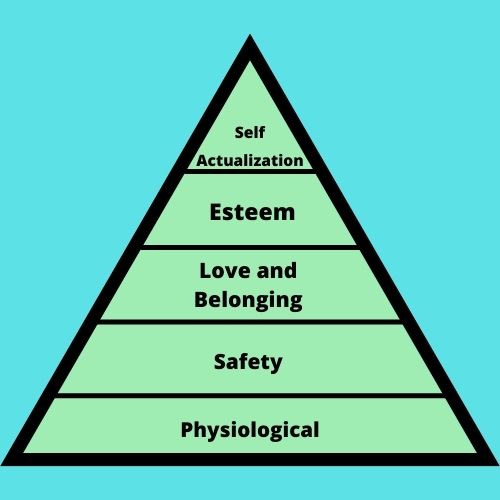Welcome to our blog post on Maslow’s Hierarchy of Needs and what truly motivates people. Have you ever wondered why we do the things we do? What drives us to strive for success, seek connection, or simply survive? Well, look no further because, in this article, we’ll delve into the fascinating concept of Maslow’s Hierarchy of Needs and uncover the layers of motivation behind human behavior.
Whether you’re a psychology enthusiast or simply curious about human nature, this exploration will offer you valuable insights and a fresh perspective on what makes us tick. Get ready to unravel the mysteries of motivation as we journey through Maslow’s Hierarchy of Needs and discover the driving forces behind human actions.
Jump To Section
What is Maslow’s Hierarchy of Needs?
The theory of Maslow’s Hierarchy of Needs suggests that people are motivated by a series of five needs, arranged in a hierarchy. A person’s most basic needs must be met before moving on to the next level. The higher up the pyramid, the more advanced and difficult to satisfy needs become.
Developed by Abraham Maslow in 1943, his hierarchy of needs is a theory that explains human motivation. This five-level model describes what motivates people to take certain actions. It is organized into a pyramid with each level more important than the one below it. The hierarchy is based on the following needs.
5 Levels of the Hierarchy of Needs Explained
The 5 levels are:
- Physiological
- Safety
- Love and Belonging
- Esteem
- Self-Actualization
Physiological

The first level is Physiological needs, the most important level of Maslow’s hierarchy of needs. Physiological needs are our most basic requirements for survival, such as air, water, food, sleep, and the like. If these areas are lacking at the base level then the higher levels of Maslow’s hierarchy of needs are hard to achieve. For example, if you are starving you’re not going to be able to concentrate on anything else until you have eaten.
Safety
Once we meet these basic physiological needs, then we start to move up the pyramid and look at safety. Safety needs to protect us from harm in any way imaginable whether it be physical, emotional, or financial harm. These include things such as a place to live and employment to provide us with a source of income. So that we can buy things we need to live such as clothing, food, and shelter.
Safety has two parts: protection from harm (including financial harm) and having a sense of stability in the world. We want to feel safe in our environment, including our homes and workplaces, as well as in our social relationships.
We also need to know that no harm will come to us from outside forces, like crime, natural disasters, or economic upheaval. This is why public institutions like police departments, fire departments, and social services are so important.

Love and Belonging
As a person meets the safety needs, the individual moves up the pyramid to meet their needs for love and belonging.
The need for love and belonging is one of the most important needs that people experience in life. It includes both healthy relationships with others and one’s sense of self-worth or self-esteem. If an individual is lacking in this area of their life, they may develop unhealthy habits to fill the void. This could lead to anything from engaging in risky sexual behavior to abusing drugs or alcohol.
A lack of love early in life can cause problems later on, like difficulty forming relationships or difficulty knowing one’s self-worth or value. This can lead to depression or low self-esteem, which could eventually lead back to risky behavior.
Love and belonging come in many different activities and forms. Including healthy friendships, romantic relationships, volunteering at a homeless shelter, or even attending religious services like church or temple. These activities do not need to directly involve other people. Some people find it easier to connect with others through art, music, or even the internet. For example, a person may find it easier to connect with others through online forums or chats.
The need for love and belonging may also be fulfilled by finding a sense of purpose. This means finding a place to fit in or belong.
Esteem
Esteem is the level of regard, respect, and honor a person has for oneself. It’s self-respect and is usually based on meeting one’s standards of excellence and on receiving recognition from others for such achievements. People want respect from others and to achieve their full potential.
Self-Actualization
The final need on the hierarchy is self-actualization. This idea comes from the concept of “realizing one’s true potential”. Self-actualized people are confident and feel they can achieve their full potential. They tend to be able to enjoy life and see things as positive, despite the difficulties they may face.
This need is often referred to as the need for self-fulfillment or self-realization. Once this need has been met it means we have developed ourselves fully as human beings. We can see ourselves as having no limits at all. This is called unlimited growth.
Self-Actualized people are truly happy with their lives because they know that everything they do will make them better people in some way. They are constantly striving to improve themselves.

How People Progress Through the Pyramid
Understanding how individuals progress through the hierarchy of needs is essential to comprehend human motivation and behavior. The hierarchy of needs, as proposed by psychologist Abraham Maslow, is a theory that suggests people are motivated to fulfill their needs in a specific order. However, the progression through these needs is not always linear, and individuals may work on fulfilling multiple levels simultaneously.
Non-linear Progression
It is important to note that people do not always progress through the levels of the hierarchy in a straight line. Life events, personal circumstances, and individual differences can impact the order in which individuals address their needs. For example, a person may prioritize their need for self-esteem and recognition over their need for social relationships, or they may work on their need for safety and security while also seeking love and belonging.
Working on Multiple Levels
People may also work on fulfilling multiple levels of needs at the same time. This can be due to the interconnected nature of our needs and the fact that satisfying one need can sometimes contribute to the fulfillment of another. For instance, a person may work on their need for love and belonging by forming close relationships, which in turn can contribute to their self-esteem and feelings of accomplishment.
Lower Levels vs. Higher Levels
Typically, the lower levels of needs (physiological, safety, and social) have more progress toward them than the higher levels (esteem and self-actualization). This is because the lower levels are more fundamental to our survival and well-being, and thus, individuals tend to prioritize fulfilling these needs before addressing the higher levels. However, it is not uncommon for people to experience progress in higher levels while still working on lower levels, as personal growth and development can occur simultaneously across multiple areas of the hierarchy.
How to Use Maslow’s Hierarchy of Needs
Maslow’s hierarchy of needs is a valuable framework for understanding human motivation and behavior. It can be applied in various aspects of life, such as education, business, and relationships, to help individuals and organizations improve their overall well-being. By identifying the stage a person is in and understanding their needs, you can better support them and build stronger connections.
Identifying the Stage
To effectively use Maslow’s hierarchy of needs, begin by identifying the stage someone is in. This can be done through observation, listening, and asking questions.
Understanding Motivations
Once you have identified the stage a person is in, you can better understand their motivations. Recognize that people are driven to fulfill their needs at their current level, and their actions and decisions may be influenced by these needs. By understanding what motivates someone, you can tailor your support and communication to better align with their needs.
Helping Fulfill Needs
To help someone fulfill their needs, consider the following strategies:
- Offer resources and assistance: Provide access to resources or support that can help address their needs, such as sharing information, connecting them with relevant individuals, or offering practical assistance.
- Encourage and empower: Encourage individuals to take steps toward fulfilling their needs and empower them to make decisions that align with their goals.
- Create a supportive environment: Foster a positive and inclusive atmosphere that facilitates the fulfillment of needs, such as promoting open communication, collaboration, and mutual respect.
Building Loyalty
By helping others fulfill their needs and supporting their personal growth, you can build loyalty and strengthen relationships. People are more likely to trust and value those who genuinely understand and care about their well-being. In turn, this loyalty can lead to increased collaboration, improved morale, and a stronger sense of community.
In conclusion, Maslow’s hierarchy of needs is a powerful tool for understanding and supporting the people around you. By identifying the stage someone is in, understanding their motivations, and helping them fulfill their needs, you can contribute to their personal growth and create lasting, loyal relationships.
Comparison of Maslow’s Hierarchy with Other Motivational Theories
While Maslow’s Hierarchy of Needs is widely celebrated, it’s essential to consider other motivational theories that provide alternative perspectives. Let’s take a look at a few!
Theory X and Theory Y by Douglas McGregor
Douglas McGregor’s Theory X and Theory Y propose contrasting assumptions about human motivation. Theory X assumes that individuals are inherently lazy and require strict supervision, while Theory Y suggests that people are self-motivated and seek responsibility. By comparing these theories, we can gain insights into different management styles and their impact on employee satisfaction and motivation levels.
Expectancy Theory by Victor Vroom
Victor Vroom’s Expectancy Theory focuses on the relationship between effort, performance, and motivation. This theory highlights the importance of expectancy (the belief that effort leads to performance), instrumentality (how performance leads to desired outcomes), and valence (the value we place on these outcomes). By exploring this theory alongside Maslow’s Hierarchy, we can gain a deeper understanding of what drives us to perform at our best.
Herzberg’s Two-Factor Theory
Herzberg’s Two-Factor Theory distinguishes between motivation factors and hygiene factors. Motivation factors, such as recognition and personal growth, drive intrinsic motivation, while hygiene factors, including working conditions and job security, primarily impact job dissatisfaction. By comparing this theory with Maslow’s Hierarchy, we can better comprehend the complex interplay between various factors that influence our overall motivation and satisfaction.
Real-Life Applications and Case Studies
The true test of any theory lies in its practical application. Let’s explore some real-life examples of how Maslow’s Hierarchy and other motivational theories have influenced strategies and brought about positive change.
Employee Recognition Programs
Companies often implement employee recognition programs to satisfy esteem needs and boost motivation. By acknowledging employee achievements and providing a platform for growth, organizations create a culture that fosters self-esteem, self-confidence, and overall job satisfaction.
Designing Work Environments
Creating a work environment that prioritizes safety, inclusivity, and opportunities for personal and professional growth aligns with Maslow’s Hierarchy and motivates employees. Companies that invest in ergonomic workspaces, safety protocols, and growth-oriented initiatives can witness a significant increase in employee engagement and overall productivity.
Motivational Strategies in High-Performing Companies
Case studies of successful implementation of various motivational theories abound in high-performing companies. By embracing a combination of motivation theories and tailoring strategies to their organizational culture, these companies have managed to unleash the full potential of their employees, resulting in exceptional performance and innovation.
Final Thoughts
As with anything in psychology, Maslow’s Hierarchy of Needs is just a model used to explain how people think and act. It’s not necessarily 100% accurate for every person, but it can be applied to many situations.
Did you find this article useful? Please share using the buttons below.


